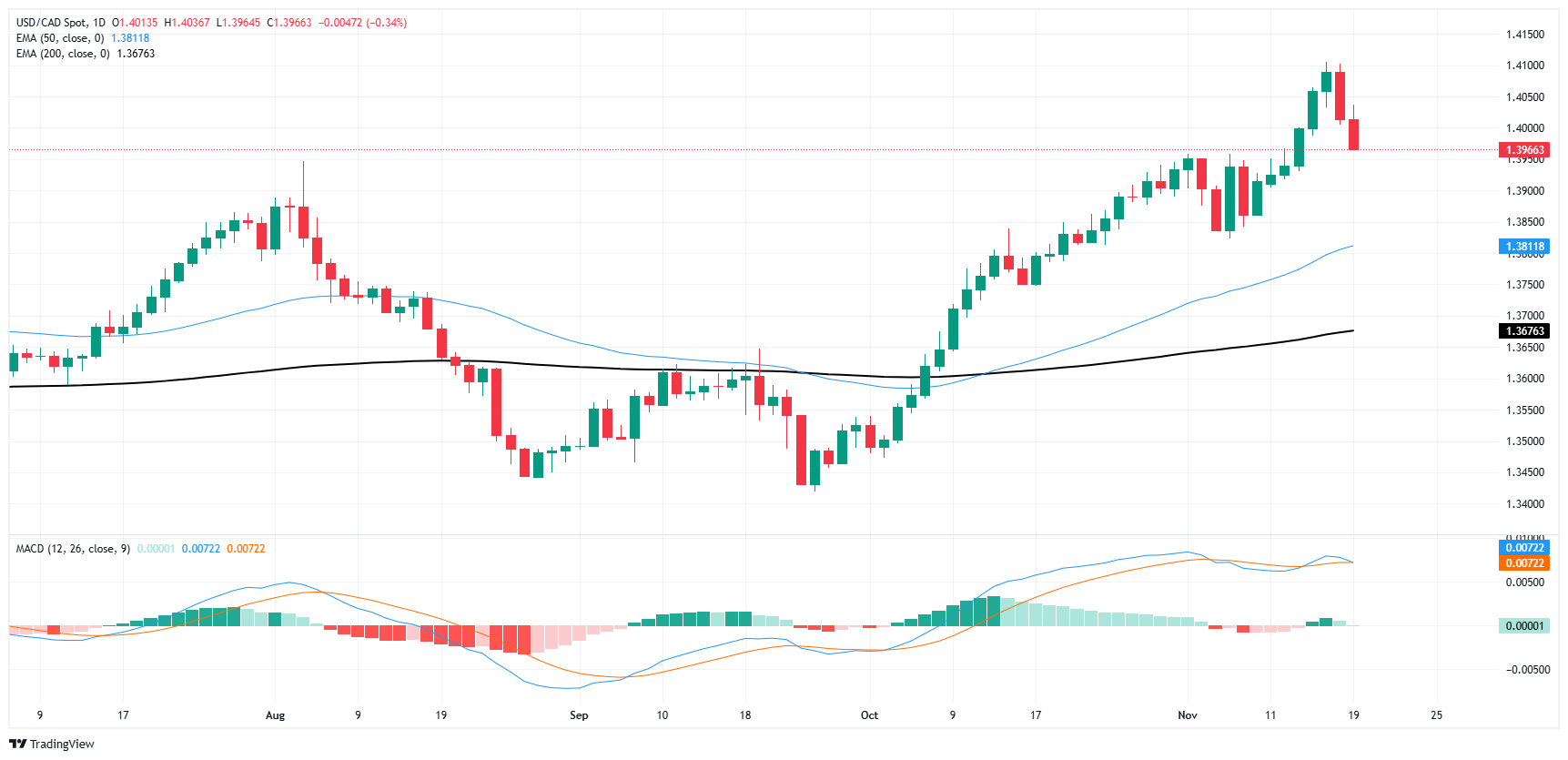Canadian Dollar extends rebound on upshot CPI print
- The Canadian Dollar gained another 0.3% on Tuesday.
- Canada saw a higher-than-expected CPI inflation print for October.
- A reacceleration of inflation is sparking hopes for further BoC rate cuts.
The Canadian Dollar (CAD) caught a bid on Tuesday, rising for a second straight day against the Greenback after Canadian Consumer Price Index (CPI) inflation rose again in October. The CAD is burning rubber against the US Dollar, recovering a full percentage point with further gains in the scope as the Loonie claws back ground after hitting 54-month lows near 1.4100.
Canada’s entire basket of CPI inflation figures swept forecasts on Tuesday, printing higher across the board and set to test the Bank of Canada’s (BoC) resolve on interest rates. The figures are still on the low side of recent history; headline annualized CPI hit a three-year low just last month. However the rebound in figures will still serve as a shot across the bow of the BoC, which is already on a path of accelerating rate cuts as the Canadian economy waffles in the post-pandemic environment.
Daily digest market movers: Canadian Dollar scrambles back from the brink
- The Canadian Dollar added back another third of a percent on Tuesday, dragging bids decisively back below the 1.4000 handle on the USD/CAD chart.
- Headline Canadian CPI inflation accelerated to 2% YoY in October, accelerating from the previous three-year low of 1.6% and outpacing the forecast of 1.9%.
- The BoC’s core CPI inflation measure also accelerated on an annualized basis, coming in at 1.7% YoY versus the previous period’s 1.6%.
- Headline CPI inflation rose to 0.4% MoM in October after September’s -0.4% contraction. Median market forecasts called for a 0.3% print.
- Except for Retail Sales figures due on Friday, Canada is functionally done with impactful releases for this week.
Canadian Dollar price forecast
The Canadian Dollar (CAD) extended a near-term recovery into a second day, clawing back from the cliff edge after hitting 54-month lows late last week. The USD/CAD chart has slid back below the 1.4000 handle amid the Loonie’s rebound, easing back a full percent from nearly five-year highs just north of 1.4100.
Despite the near-term recovery, it’s still far too early to declare a turnaround underway. USD/CAD price action is still grinding out chart paper well above the 50-day Exponential Moving Average (EMA), though CAD bulls will be invigorated as the pair appears set to continue bouncing around a multi-year sideways trend on the higher timeframes.
USD/CAD daily chart
Canadian Dollar FAQs
The key factors driving the Canadian Dollar (CAD) are the level of interest rates set by the Bank of Canada (BoC), the price of Oil, Canada’s largest export, the health of its economy, inflation and the Trade Balance, which is the difference between the value of Canada’s exports versus its imports. Other factors include market sentiment – whether investors are taking on more risky assets (risk-on) or seeking safe-havens (risk-off) – with risk-on being CAD-positive. As its largest trading partner, the health of the US economy is also a key factor influencing the Canadian Dollar.
The Bank of Canada (BoC) has a significant influence on the Canadian Dollar by setting the level of interest rates that banks can lend to one another. This influences the level of interest rates for everyone. The main goal of the BoC is to maintain inflation at 1-3% by adjusting interest rates up or down. Relatively higher interest rates tend to be positive for the CAD. The Bank of Canada can also use quantitative easing and tightening to influence credit conditions, with the former CAD-negative and the latter CAD-positive.
The price of Oil is a key factor impacting the value of the Canadian Dollar. Petroleum is Canada’s biggest export, so Oil price tends to have an immediate impact on the CAD value. Generally, if Oil price rises CAD also goes up, as aggregate demand for the currency increases. The opposite is the case if the price of Oil falls. Higher Oil prices also tend to result in a greater likelihood of a positive Trade Balance, which is also supportive of the CAD.
While inflation had always traditionally been thought of as a negative factor for a currency since it lowers the value of money, the opposite has actually been the case in modern times with the relaxation of cross-border capital controls. Higher inflation tends to lead central banks to put up interest rates which attracts more capital inflows from global investors seeking a lucrative place to keep their money. This increases demand for the local currency, which in Canada’s case is the Canadian Dollar.
Macroeconomic data releases gauge the health of the economy and can have an impact on the Canadian Dollar. Indicators such as GDP, Manufacturing and Services PMIs, employment, and consumer sentiment surveys can all influence the direction of the CAD. A strong economy is good for the Canadian Dollar. Not only does it attract more foreign investment but it may encourage the Bank of Canada to put up interest rates, leading to a stronger currency. If economic data is weak, however, the CAD is likely to fall.